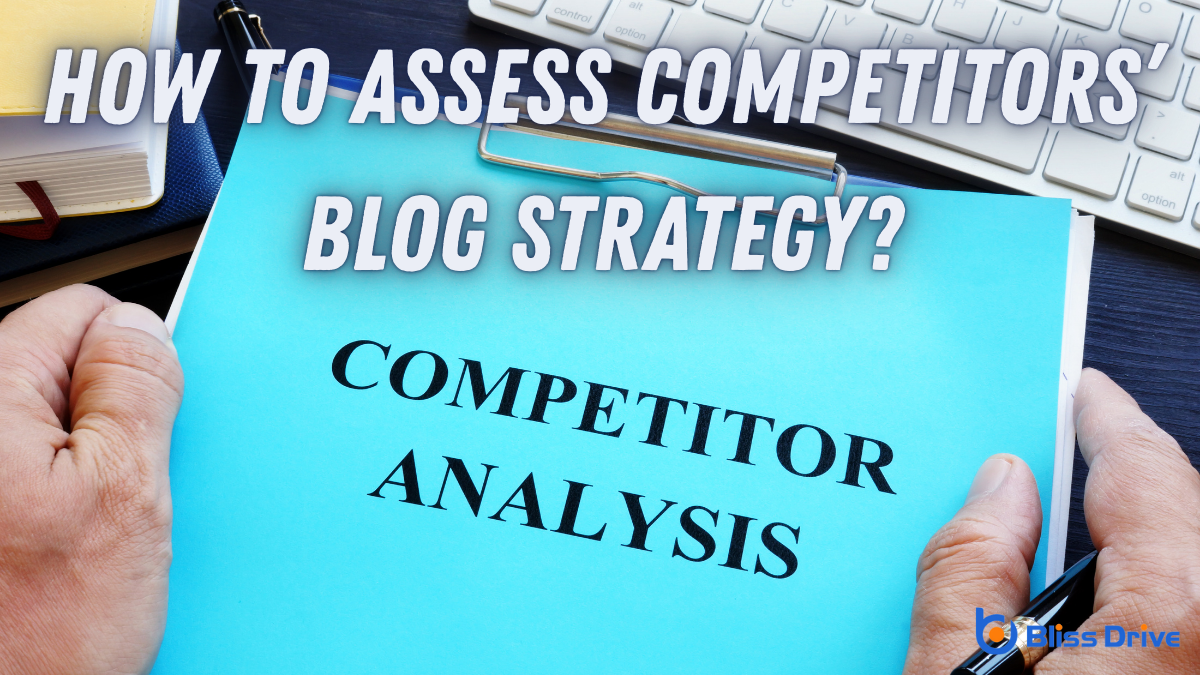Digital Marketing Services
Learn More About Us

To effectively assess your competitors' blog strategy, start by pinpointing key players in your nicheA specific segment of the market targeted by affiliates to promote products or services. and scrutinizing their online content. Look at how often they publish and the consistency of their themes. Consider how they engage their audience and the writing style they use. Don’t overlook their SEO tactics, visual elements, and conversionThe completion of a desired action by a referred user, such as making a purchase or filling out a fo... strategies. There's more to uncover, so explore these areas to gain a competitive edge.
Understanding your industry's competitive landscape is essential for crafting an effective blog strategy. You need to identify who your key competitors are to know what you're up against.
Start by researching businesses offering similar products or services. Use online tools like search engines, industry directories, and social media platforms to find competitors. Look for companies that have a strong online presence and are actively engaging with your target audience.
Consider those frequently mentioned in industry news or popular within relevant online communities. Pay attention to their website rankingsThe position at which a website appears in the SERP. and domain authority, as these indicate their influence.

How often are your competitors publishing new blog content, and do they maintain a consistent schedule? Understanding this helps you gauge their commitment to engaging their audience.
Start by monitoring their blog posts over several weeks. Note the frequency—are they posting daily, weekly, or monthly? Consistency is key; it builds audience expectations and trust.
If your competitors are sporadic, it might indicate resource constraints or a lack of strategy. However, regular posts suggest a well-planned approach.
Use tools like RSS feeds or Google Alerts to stay updated on their publishing patterns. This analysis can reveal whether they prioritize timely content delivery or struggle to keep up.
Knowing their schedule helps you identify gaps or opportunities in your own strategy.
When evaluating competitors' blogs, closely examine the themes and topics they cover to uncover their strategic focus.
Look for recurring themes, as they reveal what your competitors prioritize. Notice if they focus on industry trends, offerThe specific product or service being promoted by affiliates. how-to guides, or emphasize product features. This can indicate their approach to providing value and solving their audience's problems.
Also, assess the diversity of topics they address. Are they covering a broad range of subjects, or do they specialize in niche areas?
Analyzing the depth of information in their posts can also provide insights. Are they writing in-depth analyses or brief overviews?
Identifying your competitor's target audience is essential for refining your own blog strategy. You need to dig into who they’re writing for by examining the topics they cover and the language they use.
Look at their blog comments and social media interactions to understand who engages with their content. This gives you a sense of their audience’s demographics and interests.
Analyze their audience personas by considering the problems they’re solving and the benefits they highlight. Ask yourself what needs these readers have and how your content can address similar desires.

When evaluating your competitors’ blog writing style, start by analyzing their vocabulary choice to see if it aligns with their audience's expectations.
Next, check for tone consistency across various posts, which can reveal how well they maintain their brand voiceThe consistent tone and style of communication used by a brand across all channels..
Finally, compare their sentence structure, as it can impact readability and engagement with readers.
Vocabulary choice serves as a window into a blogger's writing style and tone, and understanding this can offer insights into their strategic approach.
When you analyze a competitor's blog, pay attention to the complexity or simplicity of their words. Are they using jargon or sticking to everyday language? This choice can reveal whether they’re targeting experts or a general audience.
Notice the frequency of certain keywords—do they align with industry trends or niche topics? This helps you gauge their focus areas and audience engagement strategies.
Additionally, consider the emotional weight of the words. Do they opt for exciting, persuasive language or a more factual, informative style? This can hint at their desired impact on readers, guiding you in crafting your own competitive content.
How consistently does a competitor maintain their tone across their blog? This consistency is vital as it shapes the brand’s identity and reader perception.
Look for patterns in their writing style. Is the tone formal, casual, or perhaps a mix? Pay attention to whether it shifts unexpectedly between posts. A consistent tone, whether professional or conversational, helps build trust and familiarity with readers.
Notice how they address their audience—do they use "you" or maintain a more distant approach? Consistency in tone aligns with the audience’s expectations and enhances engagement.
Examine their choice of words, humor, and emotional appeal. It’s about creating a recognizable voice that resonates with readers and complements the brand’s message.
Stay observant and notice how it influences the reader's connection.
After examining tone consistency, it's important to focus on how sentence structure plays into writing style and tone. By analyzing sentence structure, you can uncover the complexity and rhythm your competitors use in their blogs.
Do they favor short, punchy sentences that convey excitement, or do they prefer longer, more detailed sentences that suggest depth? This choice often reflects their target audience's preferences and can inform your own strategy.
Look for patterns: Are there frequent lists or questions? Does the writing flow smoothly, or is it choppy?
The balance between simple and complex sentences can engage readers differently. By understanding these nuances, you’ll gain insights into how competitors engage their audience, helping you refine your blog's writing approach for maximum impact.
While delving into competitors' blog strategies, you must pay keen attention to their SEO tactics and keyword usage.
Start by identifying the keywordsWords or phrases that users type into search engines to find information. they frequently use. Tools like SEMrush or Ahrefs can reveal which words drive their organic trafficVisitors who come to a website through unpaid search engine results.. Notice if they target long-tail keywordsLonger, more specific keyword phrases that are less competitive and often more targeted. or focus on high-volume ones.
Check their meta tagsHTML tags that provide information about a web page to search engines and visitors., titles, and descriptions to see how they optimize content for search engines. Analyze their backlink profile to understand which sites link to their content; this affects domain authority and search rankings.
Also, observe their internal linkingLinks that connect different pages on the same website. structure—it can enhance user experience and SEO. Understanding these tactics helps you refine your own strategy, gaining insights into what works well in your niche.
Having explored the intricacies of SEO tactics and keyword strategies, it's equally important to assess the visual elements and media use in your competitors' blogs.
Start by analyzing the type and quality of images they use. Are they high-resolution, relevant, and engaging?
Next, examine their use of video content. Do they incorporate tutorials or interviews that add value?
Look at infographics—do they present information clearly and attractively?
Evaluate the layout and design. Is it user-friendly, or does it feel cluttered?
Consider the consistency and brandingThe process of creating a unique name, design, and image for a product or service in the consumer's .... Do their visuals align with their brand identityThe visible elements of a brand, such as color, design, and logo, that identify and distinguish the ...?
Pay attention to how they use captions and alt textDescriptions added to images to help search engines understand the content of images.. These not only enhance accessibility but also boost SEO.

How do you gauge the pulse of your blog's audience? To truly understand your readers, focus on key engagement metricsMetrics that measure user interaction with a website, such as time on site and pages per session..
Analyze the number of comments each post receives. High comment counts often indicate active discussions and reader interest.
Pay attention to social media shares; they reveal how compelling your content is to your audience.
Check the average time spent on each post. Longer times suggest readers find your content engaging and worth their time.
Also, monitor the click-through rates on internal links within posts. This shows how effectively you're guiding readers to explore more of your content.
To maximize the effectiveness of your blog, it’s crucial to review your call-to-actions (CTAs) and conversion strategies regularly.
Start by examining your competitors' CTAs to understand what's working for them. Are they using buttons, text linksHyperlinked text used by affiliates to drive traffic to merchant websites., or pop-ups? Notice the language they choose—are they persuasive and action-oriented?
Analyze their placement: Are CTAs located at the top, middle, or end of a post? Also, consider the conversion paths. Do they leadA potential customer referred by an affiliate who has shown interest in the product or service but h... to a landing pageThe web page a user is directed to after clicking on an affiliate link, optimized for conversions., a product page, or a newsletterA regularly distributed email containing news, updates, and content relevant to subscribers. signup?
By understanding these elements, you can refine your approach. Remember, the goal is to guide your readers seamlessly from interest to action.
Regularly testing and tweaking your strategies guarantees your blog remains a powerful conversion tool.
To effectively assess your competitors' blog strategies, focus on identifying key players in your industry and analyzing their content frequencyThe regularity with which content is published., themes, and audience engagement. Look at their writing style, SEO tactics, and use of visuals to understand their approach. Don’t forget to evaluate their CTAs and conversion techniques. By doing so, you'll gain valuable insights into their strategies and can implement A/B testingA method of comparing two versions of a web page or app against each other to determine which one pe... to refine your own approach, ensuring continuous improvement and competitive advantage.
